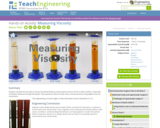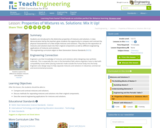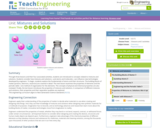
A series of interactive applets use scientific models to teach some basic concepts of matter, including states of matter and physical and chemical changes.
- Subject:
- Mathematics
- Science
- Material Type:
- Interactive
- Date Added:
- 12/01/2023

A series of interactive applets use scientific models to teach some basic concepts of matter, including states of matter and physical and chemical changes.

Chemistry is often defined as the science of matter and how it changes. This pathway introduces the composition of matter and the physical and chemical changes it can undergo.

This lesson explores the drag force on airplanes. The students will be introduced to the concept of conservation of energy and how it relates to drag. Students will explore the relationship between drag and the shape, speed and size of an object.

Students learn how volume, viscosity and slope are factors that affect the surface area that lava covers. Using clear transparency grids and liquid soap, students conduct experiments, make measurements and collect data. They also brainstorm possible solutions to lava flow problems as if they were geochemical engineers, and come to understand how the properties of lava are applicable to other liquids.

Students calculate the viscosity of various household fluids by measuring the amount of time it takes marble or steel balls to fall given distances through the liquids. They experience what viscosity means, and also practice using algebra and unit conversions.

This lesson plan introduces the properties of mixtures and solutions. A class demonstration gives the students the opportunity to compare and contrast the physical characteristics of a few simple mixtures and solutions. Students discuss the separation of mixtures and solutions back into their original components as well as different engineering applications of mixtures and solutions.

Through three lessons and their four associated activities, students are introduced to concepts related to mixtures and solutions. Students consider how mixtures and solutions and atoms and molecules can influence new technologies developed by engineers. To begin, students explore the fundamentals of atoms and their structures. The building blocks of matter (protons, electrons, neutrons) are covered in detail. The next lesson examines the properties of elements and the periodic table one method of organization for the elements. The concepts of physical and chemical properties are also reviewed. Finally, the last lesson introduces the properties of mixtures and solutions. A comparison of different mixtures and solutions, their properties and their separation qualities are explored.

Join a group of middle-school students on a visit to a laboratory at the Massachusetts Institute of Technology, where they experiment with "mystery mud" and learn about the relationships between magnetism, particle motion, and changes in the state of matter.

Did you know that water has different states? Learn all about it with Boris in Copenhagen.

Set sail with Oleif, the Viking. Make his boat move by learning all about matter and particles.

In this video segment produced for Teachers' Domain, observe frozen water in winter and liquid water in summer, at the same location. [0:31]

Very nice site with a great deal of excellent and helpful information on oxygen.

This animation explains what happens to particles when an ice cube melts or water boils.

Use this tutorial to help with the understanding and interpreting of phase diagrams. [12:36]
Khan Academy learning modules include a Community space where users can ask questions and seek help from community members. Educators should consult with their Technology administrators to determine the use of Khan Academy learning modules in their classroom. Please review materials from external sites before sharing with students.

Explains what happens to matter when it freezes and the definition of freezing point.
A free CK-12 account is required to view all materials.

This site has a brief description of the differences in particles in a gas, liquid, and solid. Animated microscopic pictures demonstrate the molecular movement in each state. Information is then summarized in an easy-to-read chart.

Explore kitchen chemistry as Ruff Ruffman competes with his brother Scruff to make the tastiest egg dish in the shape of a duck. Ruff quickly learns that liquids behave much differently than solids when poured into a pan. Will Ruff be able to create an actual duck-shaped dish? [4 min, 4 sec]

Watch a three-minute video about states of matter, sing karaoke about matter, learn vocabulary, and take a quiz.

Kids will have clarity in understanding the differences between solids, liquids, and gases. They Might Be Giants perform a catchy tune to help. [1:22]

Students are given a variety of materials and asked to identify each material as a solid, liquid or gas. They use their five senses ŰÓ sight, sound, smell, texture and taste ŰÓ to identify the other characteristics of each item.